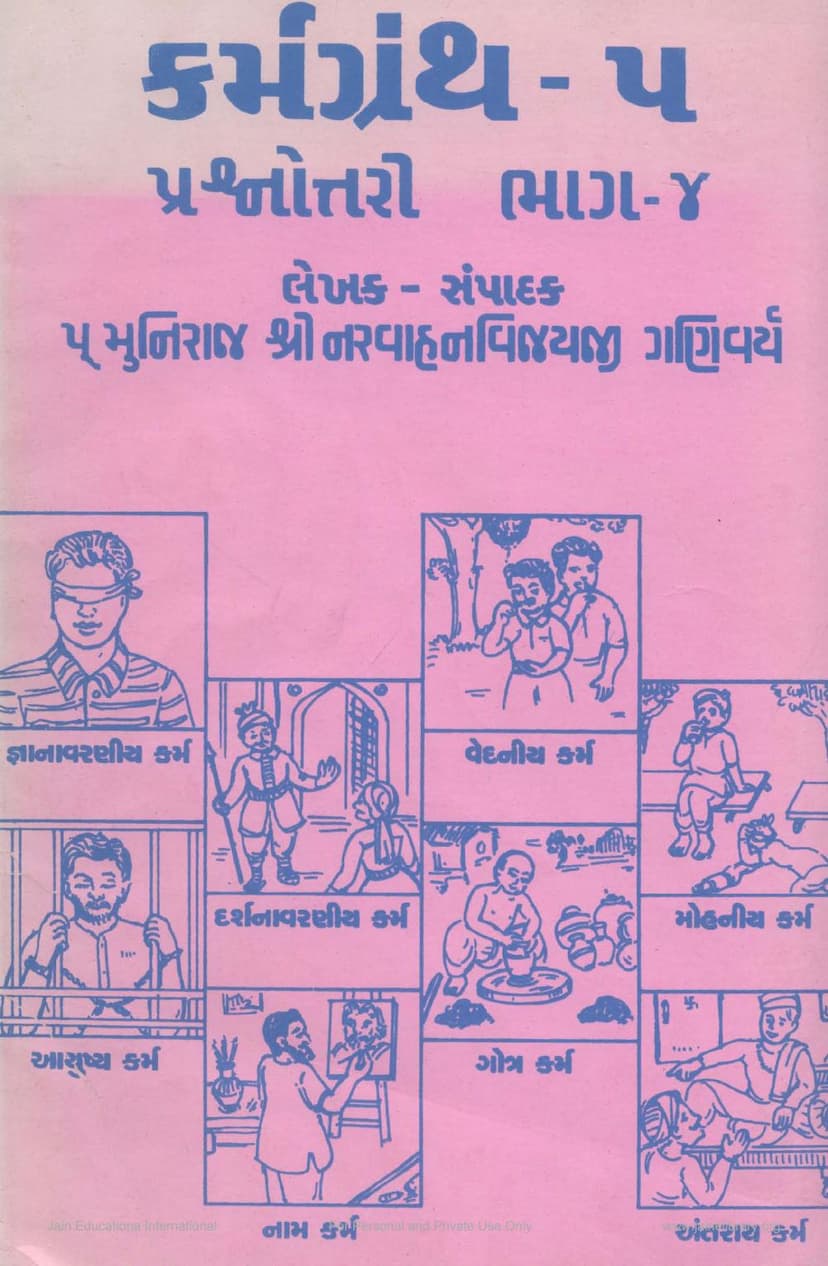Karmgranth 05 By 04 Prashnottari
Added to library: September 2, 2025

Summary
This document is the Gujarati text of "Karmgranth 05 by 04 Prashnottari" (Karm Granth - 5, Question-Answer Series, Part 4) authored by Muniraj Shri Narvahanvijayji Ganivaraya and published by Padarth Prakashan Trust. It is part of a larger series of question-answer books on Jain philosophy and principles.
The book is structured as a detailed question-and-answer dialogue focused on the intricacies of Karmic theory in Jainism, specifically elaborating on the concepts of Rasbandh (bonding of karmic essence/flavor) and Pradeshbandh (bonding of karmic particles).
Here's a breakdown of the key themes and content covered:
Core Concepts Discussed:
- Nature of Ras (Essence/Flavor): The book delves into the subtle nature of the "ras" or flavor of karma, explaining how it is bound through intensity and purity of mental states (sanklesh and vishuddhi). It uses analogies like neem and sugarcane juice to illustrate the difference between inauspicious (ashubh) and auspicious (shubh) karma.
- Ras Bandh: Extensive details are provided on how the intensity and quality of karmic bondage (ras bandh) are determined by the state of one's consciousness, particularly the degree of sanklesh (mental turmoil/attachment) and vishuddhi (purity/detachment).
- Ras Bandh Based on Kashayas (Passions): The text meticulously explains how the four types of kashayas (anantanu-bandhi, apratyakhyaniya, pratyakhyaniya, and sanjvalana) influence the type and intensity of ras bandh for both auspicious and inauspicious karmas. Each kashaya is described with analogies like lines drawn on a mountain, mud, or water to represent their varying degrees of intensity.
- Types of Ras (Ek Sthaniya, Do Sthaniya, etc.): The book categorizes the ras bandh into different "sthanas" or levels (one-stan, two-stan, three-stan, four-stan), explaining which types of karmic activities and which combinations of kashayas lead to each level of ras bandh. It provides a detailed classification of the 103 and 17 karmic natures associated with these ras sthanas.
- Utskrushth Ras Bandh (Peak Intensity Bondage): A significant portion of the book is dedicated to identifying which souls in which stages of spiritual development (gunasthanas) and under what specific mental conditions (adhyavasaay sthanas) achieve the peak intensity (utsrushth) of ras bandh for various karmic types. It covers a vast number of karmic types and their specific practitioners, from hell-beings and animals to humans and celestial beings.
- Jaghanya Ras Bandh (Lowest Intensity Bondage): Conversely, the book also explains which souls and under what conditions achieve the lowest intensity (jaghanya) of ras bandh, often through states of relative purity or intermediate mental states.
- Ras Bandh in Different Gunisthanas: The text maps out how different karmic bindings occur at various spiritual stages (gunasthanas), detailing the specific mental conditions and purities required for peak or minimal ras bandh of particular karmas.
- Varganas (Karmic Matter Aggregates): The book delves into the concept of varganas, which are aggregates of karmic particles. It explains the classification of varganas based on their composition (number of particles) and their ability to be grasped or not grasped by different types of souls and for different karmic purposes (e.g., audarik, vaikriya, aharak, etc.).
- Pradeshbandh (Bondage of Karmic Particles): The text discusses the accumulation and distribution of karmic particles. It explains how the number of particles in a karmic aggregate varies and how different entities and souls interact with these aggregates.
- Vardhamana (Increase) and Kshaya (Decrease) of Particles: It details how the number of particles in karmic aggregates can increase or decrease, influencing the intensity and manifestation of karmic effects.
- Adhyavasaay (Mental States): The role of different mental states, including sanklesh (agitation) and vishuddhi (purity), is emphasized throughout the text as the primary drivers of how karma is bound, its intensity, and its quality.
- Bandh Bhanga (Types of Bondage and Their Configurations): A substantial part of the book is dedicated to analyzing the various "bhangas" or configurations of karmic bondage, classifying them based on factors like sadi (beginning), anadi (beginningless), dhruva (eternal), and adhruva (non-eternal), as well as the types of ras bandh (jaghanya, ajaghanya, utkrushth, anutkrushth).
- Gunashreni (Stages of Purification): The book describes the eleven stages of spiritual purification (gunashrenis) and how the intensity of karmic binding and the process of purification evolve through these stages. It explains the specific activities and mental states associated with each stage in the context of karma dissolution.
- Pudgal Paravart (Transformations of Karmic Matter): The text introduces the concept of Pudgal Paravart, explaining the immense scales of time and the transformation of karmic matter through various cycles of gross (bādar) and subtle (sūkṣma) processes, related to time, space, substance, and mental states. This is used to illustrate the vastness of karmic processes.
- Spashtavādya (Tastes and Touches): It details the specific tastes (ras) and touches (sparsh) associated with different karmic particles and their impact.
- Shreni (Ladder/Stages): The text explains the concept of Upasham Shreni (stages of pacification of passions) and Kshepak Shreni (stages of eradication of passions) as pathways to spiritual liberation, detailing the process of karma dissolution at each stage.
- Vargana (Aggregates of Karmic Matter): The book further elaborates on different types of varganas based on their subtleness and how they are utilized by souls for their physical bodies and mental activities.
Overall Purpose:
The book aims to provide a comprehensive and detailed understanding of karmic science according to Jainism, answering specific questions about the nuances of karma bondage, its intensity, its classification, and the processes of its reduction and eradication through spiritual practice. It serves as a guide for individuals seeking to understand the mechanisms of karma and how to navigate the cycle of birth and death by purifying their karmic substances.